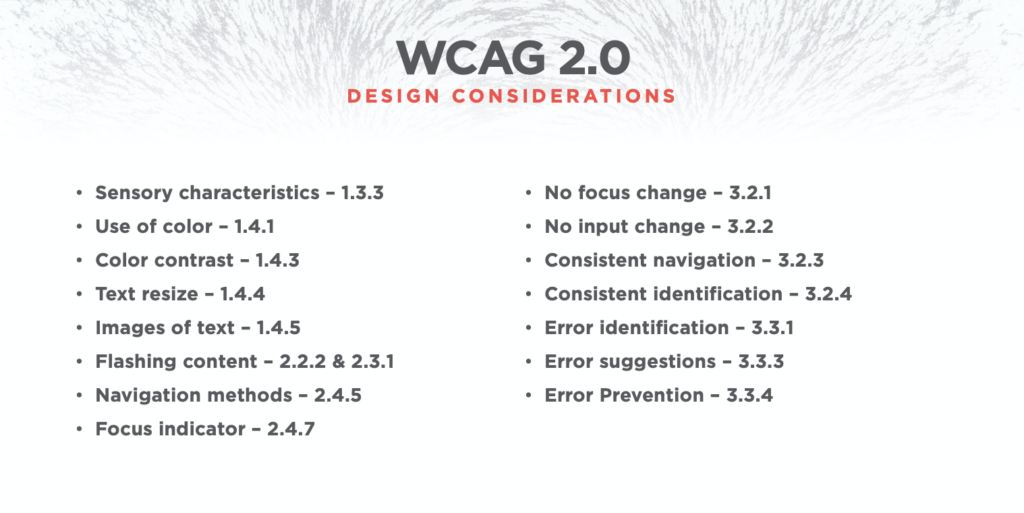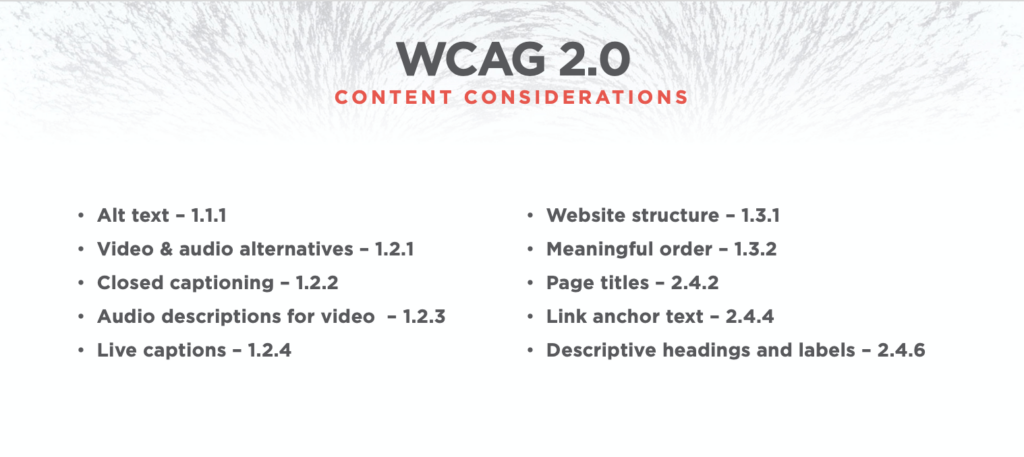What the Rising Importance of ADA Compliance Means for Your Website
Important disclaimer: We’re marketers, not lawyers – and this is not meant to be legal advice. Just friendly marketing recommendations from a group of people obsessed with providing excellent online user experiences.
The topic of web accessibility has become more prominent over the past few years and the conversation has become defined enough – and the liability risks have increased enough – that it’s worth focusing on for your website.
With more and more accessibility-based-lawsuits primarily against smaller- and medium-sized companies, U.S. Courts have established precedents that Title III of the American Disabilities Act (ADA) applies to websites.
Here’s what you need to know about the term ‘website accessibility’ and what you need to do to ensure you’re compliant with the ADA; aka, your website is inclusive and accessible to all audiences and you’re protected from a potential lawsuit.
What does ‘website accessibility’ mean?

Website accessibility means that websites are designed and developed in a way that people with disabilities are able to use them. Ease of use and clear visual contrasts are key, and working towards increased accessibility can help more people navigate your site with older devices or slower internet connections.
There’s no exact line in the sand on what constitutes an ‘accessible’ site vs. a non-compliant, inaccessible one, but more and more systems are arriving that can help you evaluate a level of accessibility. And when it comes to legal liability, ADA Compliance is the standard to look to.
What is ADA Compliance?
The primary law that governs accessibility in the U.S. is the Americans with Disabilities Act (ADA) which was passed in 1990. In 2010, it was ruled that the ADA applied to electronic and online information, and, more recently, Title III of the ADA has been interpreted by U.S. courts to apply directly to websites.
Title III of the ADA
Stated in the ADA standards:
“Title III prohibits discrimination on the basis of disability in the activities or places of public accommodations (businesses that are generally open to the public and that fall into one of 12 categories listed in the ADA, such as restaurants, movie theaters, schools, day care facilities, recreation facilities, and doctors’ offices) and requires newly constructed or altered places of public accommodation—as well as commercial facilities (privately owned, nonresidential facilities such as factories, warehouses, or office buildings)—to comply with the ADA Standards.”
“Public accommodation” is where more and more courts are deciding that websites enter the picture. If your business falls into one of the categories listed above or in the twelve ADA categories, compliance is something you should put energy towards in 2021. The 12 categories are:
- Places of lodging
- Food and drink establishments
- Place of exhibition or entertainment
- Places of public gathering
- Sales or rental establishments
- Service establishments
- Public transportation terminals, depots, or stations
- Places of public display or collection
- Places of recreation
- Places of education
- Social service center establishments
- Place of lodging
Even if your business falls outside of those 12 categories, there’s a strong chance that the rising emphasis on accessibility will soon encompass more types of organizations and could even start to impact areas of marketing like search engine visibility.
Plus, making your website inclusive and accessible to more people is key if you’re trying to grow your online footprint and deliver high-quality user experiences.
How do we make our websites accessible and ADA compliant?

The spirit behind compliance is driven by enabling everyone to enjoy the “full and equal” use of a website. The buzz phrase you’ll commonly see online and in court cases is “effective communication”:
Does your website provide effective communication?
When evaluating equal compliance in the case of a lawsuit, U.S. courts and the Department of Justice have continually referenced the Web Content Accessibility Guidelines (WCAG) 2.0 Level AA success criteria as the standard.
How to Navigate WCAG 2.0
The WCAG 2.0 success criteria was developed by people and organizations around the world with the goal of nailing down a single shared web accessibility standard. Levels of compliance with these requirements include:
- A
- AA
- AAA – with AAA being the strictest.
While WCAG doesn’t constitute the law, it does serve as one of the more helpful technical reference points available. Despite recent precedents, private entities still have an amount of flexibility when it comes to web accessibility, and striving to achieve AA status serves as a good benchmark for protecting your business and opening your website to inclusive audiences.
WCAG 2.0 provides standards in two main areas:
- Design Considerations
- Content Considerations
Here’s a quick table of contents for each set of considerations:


Where to focus on compliance first
It’s easy to start reading, get overwhelmed, and feel like AA compliance with WCAG 2.0 is an impossible mountain to climb. However, one thing the global community of developers is excellent at is finding ways to help each other, and, as these guidelines have gained importance, tools and simplified principles have emerged to help you assess the state of accessibility on your site through the lens of WCAG 2.0 without a law degree.
To help focus the most important areas of compliance, ask yourself the following two questions:
- What is the primary purpose of the website?
- What are the common paths that visitors take once they’re on the website?
Compliance boils down to making sure both the primary purpose and common paths are clear of any barriers that could potentially prevent access or cause frustration.
Tools that Can Help
A few extremely helpful summaries and diagnostic tools have risen to the internet surface to help you navigate your journey to website compliance:
W3C – WCAG 2.0 full documentation: For any lawyers reading or those who really want to dive in deep to the latest accessibility standards.
WCAG Quick Reference: A helpful cliff notes guide to WCAG standards written by the standards writers themselves.
Siteimprove Accessibility Checker / Chrome Extension: A Chrome extension that gives you a nice left-hand sidebar menu of all the areas that need attention.
WAVE Evaluation Tool / Chrome Extension: Another Chrome extension that can help you identify any gaps or areas that need some love.
Quick Reference of ADA rules that have been deemed more important from a legal standpoint: If you’re strictly concerned with legal liability, here’s a reference to the top points of concern when it comes to lawsuits.
Okay, I see the areas that need improvement on my website. How much does it cost to fix them?
From our initial audits and work on the websites we touch every day, the majority of compliance issues center around form inputs, dated html, and color contrast. The cost range for Magneti to fix these types of issues and get you to AA compliance is typically between $3k and $15k.
Factors that can affect cost:
Level of compliance: As the strictest standard, AAA compliance requires the largest amount of changes and considerations. Most organizations can protect themselves and increase the accessibility of their site with AA compliance. However, organizations that fall in the public sector, or organizations that directly serve those with disabilities might want to consider an investment in AAA.
Foundational meta data: If you’re looking to retrofit your site with increased accessibility, whether or not you have basic items like alt tags on your imagery can influence how much work it takes to bring things up to standard.
Overall volume of content on your site: Depending on the types of fixes needed, you can multiply those by the volume of content to get an accurate picture of the work required.
Amounts of generic links & buttons: Generic link text and button text need to be updated to clarify where they send users, either in the html using an aria-label or through clear language in the link text itself. The more unspecified links and buttons, the more items that need to be updated.
Outdated HTML: Sites that have been around for a while may have lots of blog posts or general page content originally copy and pasted from a word document. Sifting through and removing empty heading tags and instances of <b>, <i>, <u>,</u></i></b>, <etc> is required to bring these up to standard.
Talk to Magneti about my website’s accessibility
Minimizing legal liability is important. But so is opening the doors to your website so that everyone can use it.
To recap, website accessibility is becoming more important – both legally, in order to protect your organization from a potential lawsuit, and socially, to open the doors of the internet to everyone. Increased accessibility can help you grow your digital presence by lowering the barriers to navigating your site, whether it’s from different devices, at different internet speeds, or by audiences with disabilities.
In the case of a lawsuit, WCAG 2.0 is the rising standard, and AA level compliance is aspirational and a good target to aim at for most businesses. If you want Magneti’s support diagnosing and addressing what’s not up to standard, we’re happy to help!